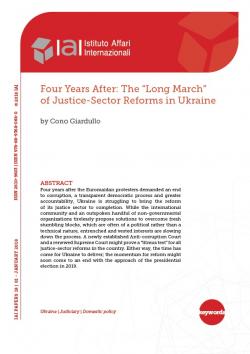Four Years After: The "Long March" of Justice-Sector Reforms in Ukraine
Four years after the Euromaidan protesters demanded an end to corruption, a transparent democratic process and greater accountability, Ukraine is struggling to bring the reform of its justice sector to completion. While the international community and an outspoken handful of non-governmental organizations tirelessly propose solutions to overcome fresh stumbling blocks, which are often of a political rather than a technical nature, entrenched and vested interests are slowing down the process. A newly established Anti-corruption Court and a renewed Supreme Court might prove a “litmus test” for all justice-sector reforms in the country. Either way, the time has come for Ukraine to deliver; the momentum for reform might soon come to an end with the approach of the presidential election in 2019.
-
Details
Roma, IAI, January 2018, 22 p. -
In:
-
Issue
18|01
Introduction
1. Who wants to reform the judiciary?
1.1 An overview of the main judicial reforms
1.2 Reform-pushers: international actors and civil society
1.3 The turn of the tide: the constitutional amendments and the law of judiciary
2. Who does not want to reform the judiciary?
2.1 Barriers to reform: the judiciary and who else?
2.2 The renewal of the Supreme Court: a failed test for civil society
2.3 A new Anti-corruption Court: time to deliver
Conclusion
References



